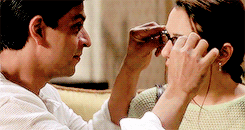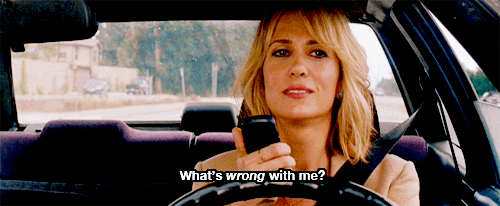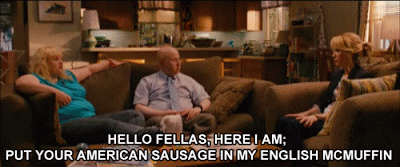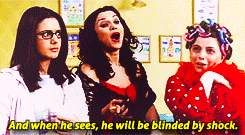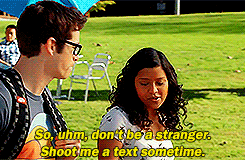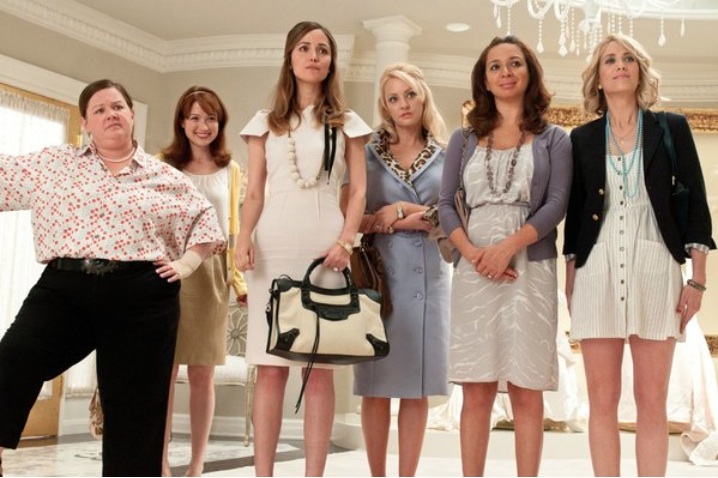
Remember when much of mankind stuck its collective head inside an oven and randomly decided women couldn’t be funny (despite the existence of 30 Rock, Mo’Nique, and Lucille Ball’s entire oeuvre?) Then we got Bridesmaids — a movie whose entire cast was filled with women being funny. Suddenly all the chapters of the He-Man Woman Haters Clubs of America somehow got over themselves. Like, it dawned on them that a film does not need a dude or a group of dudes to be legitimately funny. WE ARE LIVING IN REVOLUTIONARY TIMES, PEOPLE.
Female Friendships in Film For The Win!
Bridesmaids was a perfect film; it was a perfect film because its protagonists were flawed, but because it actually depicted friendships between women — and it depicted women as humans, not as accessories to men. For much of the film, it even passed The Bechdel Test! It was a perfect film and we know it was perfect because everybody had Thoughts and Feelings about it; nobody would shut up about it. It only took 91 years after Susan B. Anthony fought for the right for all women to be able to vote, but hey! we got here! America finally decided that a film primarily featuring all women could be funny!
So it’s bittersweet that we look at the Bollywood landscape — it’s a horizon that’s littered with the husks and facsimiles of movie tropes that have already worked and paid out big in the West. It’s the realm where I Now Pronounce You Chuck and Larry was kind-of, sort-of transliterated into Dostana; where Three Men and a Baby is 20 years later reborn as Hey Babyyy; where The Hangover serves as inspiration for Zoya Akhtar’s Zindagi Na Milegi Dobara. Notice a pattern? These are all dude-centric films where dudes get into antics and have a hilarious time trying to get out of said antics. Any involvement by women is marginal, expository, or otherwise verges on set dressing.
So in a post-Bridesmaids world, why is it that Bollywood hasn’t even mused on adapting the 2011 blockbuster?
World’s Biggest Film Industry Condones Misogyny
Recently, Tasneem Nashrulla and Rega Jha jointly penned this eye-opening survey on how exactly the Bollywood industry contributes to rape culture and misogyny. Bollywood is a prolific and far-reaching film industry — and in many regards — it’s an industry that manages to capture audiences that Hollywood is still figuring out:
Bollywood, churning out films at a rate of a thousand per year, is far and away the largest film industry in the world. More pertinently, at a viewership around 50 million, the industry reaches more Indians than any other cultural phenomenon.
Despite any progress made in this industry, Bollywood pretty wholesale tends toward reductive female characters. Per Nashrulla and Jha’s feature, “Bollywood does condone a culture of misogyny and sexual harassment that contextualizes and allows rape.”
This happens a variety of ways — it happens when everyone from veteran screen legends like Rekha and Aishwarya Rai are trotted out as item girls:
When you take titans of the industry and reduce them to throwaway coquettes — and devices to further delve into the masculinity of a film’s heroes — and you do this at least once or twice per Bollywood blockbuster, you lay the groundwork for an entire culture to begin regarding women as tropes.
Bollywood Fails the Bechdel Test
Beyond item numbers, Bollywood as a genre tends to fail the Bechdel Test regularly. Women — dutiful wives and daughters, distraught damsels-in-distress, one-dimensional sex-pots — seem only to meditate on the men in their lives. The myth of Bollywood would have women believing that they are nothing more than the function of men’s needs.
Other times, films do a remarkable of building up women as self-sufficient characters who don’t exist as accessories to men–but then they end up dismantling that set-up to shoehorn those characters into these roles anyway.
I turn to one of my favorite Bollywood flicks ever — 2003’s Kal Ho Naa Ho. In it, Preity Zinta plays Naina Catherine Kapur, a quirky, no-nonsense single woman studying to get her MBA, taking care of her family, and helping to run her family’s restaurant business. Kind of an awesome heroine as Bollywood heroines go.
She’s a force!
Then one day, Aman (Shah Rukh Khan) comes strolling along and makes her realize that she’s been uptight all this time and she needs to be more carefree. Aman helps Naina’s family get their business in the black. He gets along with everyone!
He also points out to Naina that, by the way, she needs to fall in love with a man (not him, but another man, a loveable douchebag named Rohit played by Saif Ali Khan). That’s right. Kal Ho Naa Ho doesn’t think it’s awful enough to have Naina play accessory to one man, but then turns her erstwhile platonic friendship into a romantic endeavor, where she ends up playing accessory to a second man.
What’s problematic about Aman is that from the moment he trots on-screen until his last line, the film re-contextualizes Naina’s narrative around the larger need to establish and re-establish Aman as a messianic figure. Naina becomes just another problem for Aman to fix and goes onto surrender her agency in order to let Aman’s master plan of fixing everything and everyone come together.
Bear in mind, this is one of Bollywood’s more progressive films — where a heroine was allowed a degree of independence and at least for the film’s first 30 or 40 minutes, an identity outside of her relationship with any hero.
Can Reel Women Be Real Women in Bollywood?
Part of Bridesmaids‘ success (all of it?) is owed to the fact that its leads are allowed to be human. They’re flawed, messy, and most importantly, inelegant.
In other words, it’s a film where women are allowed to be as ridiculous as men are — except men enjoy this kind of carte blanche regularly and get to dodge silly questions like, “Can men be funny?”
This also lays bare why Bollywood hasn’t even hinted at adapting a film that grossed $160M domestically and another $120M internationally. The genre is unwilling or unable to execute treatments of women that allow them to be as crass and frank as men.
Or when they do, it’s through characters who have been established as comic relief. Like the one-two punch of sisters Jazz (Lillete Dubey) and Sweetu (Delnaaz Paul) from Kal Ho Naa Ho, who serve simply to underscore how undesirable flawed women are when held up to archetypes like Naina. Jazz (middle) is a cougar and Sweetu (right) is loves food and is always unlucky in love.
Imagine for yourself how incredible it would be if the above still was from a movie that starred those three as leads in a film that didn’t require a hero –and featured them sharing equal amounts of screentime, working through their problems, with hilarious results.
Exactly.
Bollywood Needs Female Buddy Comedies More Than Ever
This isn’t just a fleeting yen to see a gaggle of Bollywood talent on-screen trading barbs — although can you imagine the sparkly excellence of Shilpa Shetty, Sonam Kapoor, and Konkona Sen Sharma riffing jokes off one another? It is basically a concern to see South Asian culture struggling to keep up with changing global attitudes towards sex and gender.
We are in an era where Mindy Kaling and emerging talents like Aparna Nancherla, Tiya Sircar, and Sharmila Devar demonstrate that there are growing opportunities for actresses of South Asian descent. These opportunities allow them to portray fully-realized characters with rough edges. The brashness of Sircar’s character from The Internship immediately comes to mind:
While characters in Bollywood films frequently amount to tropes and caricatures, in years past, they at least connected with audiences.
That was a world before Kelly Kapoor was delivering the best zingers ever on The Office, though. We’re now in an era where characters — especially representations of women — are connecting so little with audiences that those same audiences can now explore TV shows and movies in other markets for more reasonable characters.
If Hollywood — and adjacent film industries in other Western markets — can leapfrog over Bollywood by providing more dynamic and representational characterizations of female characters, especially by way of buddy comedies, then they stand to break off a substantial piece of the very international market that Bollywood grows more and more dependent on. Which is exactly why now is the tipping point for Bollywood to start churning out buddy comedies starring women.
Bridesmaids was a bellwether film not only for Hollywood, but for cinema industries globally — its global box office impact demonstrated that there is a huge demand among all kinds of people to see more honest and accurate representations of women. While not all women are known for getting messy when their best friends are getting married — they are known for having feelings and having lives outside of men.
It’s about time Bollywood fast-tracked films to meet that goal — unless they want to be left on the cutting room floor.


